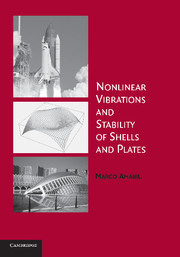Book contents
- Frontmatter
- Contents
- Preface
- Introduction
- 1 Nonlinear Theories of Elasticity of Plates and Shells
- 2 Nonlinear Theories of Doubly Curved Shells for Conventional and Advanced Materials
- 3 Introduction to Nonlinear Dynamics
- 4 Vibrations of Rectangular Plates
- 5 Vibrations of Empty and Fluid-Filled Circular Cylindrical Shells
- 6 Reduced-Order Models: Proper Orthogonal Decomposition and Nonlinear Normal Modes
- 7 Comparison of Different Shell Theories for Nonlinear Vibrations and Stability of Circular Cylindrical Shells
- 8 Effect of Boundary Conditions on Large-Amplitude Vibrations of Circular Cylindrical Shells
- 9 Vibrations of Circular Cylindrical Panels with Different Boundary Conditions
- 10 Nonlinear Vibrations and Stability of Doubly Curved Shallow-Shells: Isotropic and Laminated Materials
- 11 Meshless Discretizatization of Plates and Shells of Complex Shape by Using the R-Functions
- 12 Vibrations of Circular Plates and Rotating Disks
- 13 Nonlinear Stability of Circular Cylindrical Shells under Static and Dynamic Axial Loads
- 14 Nonlinear Stability and Vibration of Circular Shells Conveying Fluid
- 15 Nonlinear Supersonic Flutter of Circular Cylindrical Shells with Imperfections
- Index
- References
3 - Introduction to Nonlinear Dynamics
Published online by Cambridge University Press: 08 January 2010
- Frontmatter
- Contents
- Preface
- Introduction
- 1 Nonlinear Theories of Elasticity of Plates and Shells
- 2 Nonlinear Theories of Doubly Curved Shells for Conventional and Advanced Materials
- 3 Introduction to Nonlinear Dynamics
- 4 Vibrations of Rectangular Plates
- 5 Vibrations of Empty and Fluid-Filled Circular Cylindrical Shells
- 6 Reduced-Order Models: Proper Orthogonal Decomposition and Nonlinear Normal Modes
- 7 Comparison of Different Shell Theories for Nonlinear Vibrations and Stability of Circular Cylindrical Shells
- 8 Effect of Boundary Conditions on Large-Amplitude Vibrations of Circular Cylindrical Shells
- 9 Vibrations of Circular Cylindrical Panels with Different Boundary Conditions
- 10 Nonlinear Vibrations and Stability of Doubly Curved Shallow-Shells: Isotropic and Laminated Materials
- 11 Meshless Discretizatization of Plates and Shells of Complex Shape by Using the R-Functions
- 12 Vibrations of Circular Plates and Rotating Disks
- 13 Nonlinear Stability of Circular Cylindrical Shells under Static and Dynamic Axial Loads
- 14 Nonlinear Stability and Vibration of Circular Shells Conveying Fluid
- 15 Nonlinear Supersonic Flutter of Circular Cylindrical Shells with Imperfections
- Index
- References
Summary
Introduction
Different from linear systems, where the superposition theorem holds true, vibrations of nonlinear systems can give rise to multiple coexisting solutions, bifurcations and very complex dynamics. This chapter introduces nonlinear dynamics, focusing on the concepts and tools used in the following parts of the book to study nonlinear vibrations of plates and shells.
The resonance frequency of a nonlinear system changes with the vibration amplitude. For very small amplitudes, it coincides with the natural frequency of the linear approximation. For larger amplitudes, the resonance frequency decreases with amplitude for softening systems and increases with amplitude for hardening systems.
Static solutions and their bifurcations can be analyzed by using a local geometric theory. For periodic solutions, the Floquet theory may be used to study the stability and to classify the bifurcations. Numerical techniques are used to find solutions and to follow solution branches, such as the arclength and pseudo-arclength methods.
Hints are given on internal resonances, quasi-periodic and chaotic vibrations, Poincaré maps, Lyapunov exponents and the Lyapunov dimension, which are used to identify complex dynamics.
At the end of this chapter, two different methods are introduced to discretize partial differential equations, which govern vibrations of continuous systems, such as plates and shells. These are the Galerkin method and the energy approach that leads to the Lagrange equations of motion; they allow us to obtain a finite set of ordinary differential equations from the original partial differential equations.
Information
- Type
- Chapter
- Information
- Nonlinear Vibrations and Stability of Shells and Plates , pp. 90 - 119Publisher: Cambridge University PressPrint publication year: 2008
